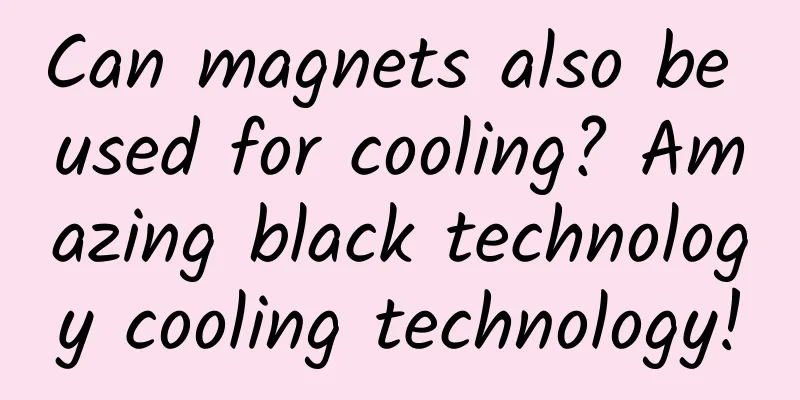Can magnets also be used for cooling? Amazing black technology cooling technology!

|
Can magnets also be used for cooling? Amazing black technology cooling technology! With its unprepossessing appearance and a heart that is hot on the outside but cold on the inside, the air conditioner is the undisputed centerpiece of summer life-saving gadgets. When you are sweating profusely, the compressor in the air conditioner keeps working, bringing you a hint of coolness, but it also produces a buzzing noise that is annoying. However, there is a refrigeration technology that is like "magic" and can quietly lower the temperature under a changing magnetic field. This is magnetic refrigeration. Magnetic refrigeration technology is a unique and interesting cooling method. It can provide us with cooling effects efficiently and environmentally friendly, and has great potential in many fields. Today, let us unveil the mystery of magnetic refrigeration and see how it works. (Photo source: Material China) PART.1 What is magnetic refrigeration? Magnetic refrigeration is a refrigeration technology based on the magnetocaloric effect. You can imagine that a piece of magnetic material changes temperature under the action of an external magnetic field, thereby generating cold air. So, what kind of material will have magnetocaloric effect? First, we need to understand the basic characteristics of magnetic materials. From a microscopic perspective, magnetic materials are usually composed of many tiny magnetic particles, each of which has a magnetic moment inside it, which is determined by the spin and orbital angular momentum of the electron. The arrangement between these particles often has four states, corresponding to four types of magnetism: ferromagnetism, ferrimagnetism, paramagnetism, and antiferromagnetism. Classification of magnetic materials, made by the author When a magnetic material is placed in an external magnetic field, the magnetic moments will rearrange to adapt to the external magnetic field. This rearrangement process is called magnetic moment orientation . Paramagnetic materials are materials with spontaneous magnetic moments, and their magnetic moments are always oriented along the direction of the external magnetic field. When there is no external magnetic field, it exhibits paramagnetism to the outside; under the action of an external magnetic field, its magnetic moments are orderly arranged along the external magnetic field, and it exhibits ferromagnetism to the outside. In addition to the external magnetic field, temperature can also rearrange the magnetic moment. Most magnetic materials are ferromagnetic or ferrimagnetic below a certain temperature point, and paramagnetic above this temperature point. The temperature point mentioned above is the Curie temperature (Tc), also known as the magnetic transition point . The Curie temperature determines the temperature range in which the magnetic material can serve. Different magnetic materials have different Curie temperatures, which makes magnetic refrigeration technology widely used, with different applications from room temperature to extremely low temperatures. How does the magnetocaloric effect occur? What is the relationship between magnetic moment orientation and thermal effect? What scientific principles are involved? In fact, the arrangement of magnetic moments is like our room. If we don't clean it up, it will become more and more chaotic. In physics, there is a physical quantity called entropy that is used to measure the degree of chaos in a system. For an isolated system, the higher the degree of chaos, the higher the entropy, and vice versa. Entropy and degree of chaos, source: Qianku.com There are two main types of entropy in magnetic materials: magnetic entropy and thermal entropy. Magnetic entropy refers to the ordered disorder of magnetic moments; thermal entropy refers to the vibration mode of the molecules or atoms that make up the material. The more and more violent the vibration modes are, the greater the thermal entropy will be. The sum of these two entropies is the total entropy of the magnetic material. When the total entropy changes, it may be a change in magnetic entropy or thermal entropy, or both may change; and when the total entropy does not change, it does not necessarily mean that both magnetic entropy and thermal entropy do not change, it may be that one increases and the other decreases. The magnetocaloric effect is achieved through the "loss and gain" between magnetic entropy and thermal entropy. In order to keep the total entropy unchanged, the magnetocaloric material needs to be in an adiabatic environment. An adiabatic environment means that there is no heat exchange between the entire system and the outside world, and heat cannot come in or go out. At this time, when an external magnetic field is applied to the magnetic material, the magnetic moments are arranged neatly, the magnetic entropy decreases, and the thermal entropy will increase, and heat will be released; on the contrary, when the magnetic field is removed, the thermal entropy decreases and heat needs to be absorbed, which has a cooling effect. Magnetic refrigeration, which sounds mysterious, is nothing more than a "seesaw game" of loss and gain. Principle of magnetocaloric effect, made by the author Although the basic principle of magnetic refrigeration is simple, it still requires some ingenious ideas to design this principle into equipment that can serve various fields. In order to realize the magnetic refrigeration process, components such as magnetic materials, magnetic field sources and heat exchangers are needed. First, in an adiabatic environment, applying an external magnetic field will cause the magnetic material to change its magnetic moment orientation and release heat. The heat will then be discharged from the radiator through the heat exchanger. When the magnetic field is removed, the temperature of the magnetic material decreases. Compared with the object being cooled, the temperature of the magnetic material is lower, so the magnetic material absorbs the heat in the object being cooled, lowering its temperature. This cycle repeats itself, forming a closed loop for heat flow. Repeated cycles continuously absorb the heat of the object being cooled, achieving the cooling effect. Schematic diagram of magnetic refrigeration system, made by the author PART.2 Highly efficient and energy-saving magnetic refrigeration In practical applications, magnetic refrigeration has many unique advantages: 1) Green and environmentally friendly. Magnetic refrigeration does not require the use of any environmentally harmful chemicals, which is significantly different from the traditional compressor refrigeration method. The traditional method requires the use of refrigerants to absorb and release heat. These refrigerants contain some organic fluorides, ammonia and hydrocarbons, which have the defects of destroying the ozone layer, being toxic, easy to leak, flammable and explosive, etc. 2) High efficiency and energy saving. The magnetic refrigeration system achieves cooling through changes in the magnetic field, rather than through mechanical compression of gas as in the traditional way. This means that magnetic refrigeration can operate at very low temperatures and consume less energy. The theoretical efficiency of magnetic refrigeration can reach 60-70% of the Carnot cycle efficiency, while gas compression refrigeration is generally 20-40%. In other words, under the same other conditions, the power consumption of magnetic refrigeration is only about 50% of that of traditional compression refrigeration refrigerators; 3) Stable and reliable. Magnetic refrigeration does not require a gas compressor, has few moving parts, no vibration, zero noise, high reliability, long life, and easy maintenance; Because of these advantages, magnetic refrigeration technology is widely used in aerospace, medical, electronics and other fields. According to the application temperature zone, magnetic refrigeration is mainly used in ultra-low temperature zone (<1 K, such as quantum computing, etc.), low temperature zone (such as nuclear magnetic resonance imaging, gas liquefaction, etc.) and room temperature zone (such as air conditioning, refrigerator, etc.). Application of magnetic refrigeration, made by the author At present, the total industrial output value of my country's refrigeration and air-conditioning industry exceeds 1 trillion yuan, and the electricity consumption for refrigeration exceeds 15% of the total electricity consumption in the country, making it a well-deserved energy consumer. Most of the refrigerants currently in widespread use have a large greenhouse effect, and emissions caused by refrigerant leakage are an important part of my country's greenhouse gases. Now, the refrigeration and air-conditioning industry is in a critical period of implementing the "Green and Efficient Refrigeration Action Plan" and responding to global climate change. As a zero-carbon energy refrigeration technology, magnetic refrigeration has the advantages of being green, environmentally friendly, efficient, energy-saving, stable and reliable, making it likely to become one of the solutions to replace room temperature vapor compression refrigeration technology. Power consumption forecast for the refrigeration and air conditioning industry and the percentage of power savings in various fields. Source: 2022 Green Refrigeration Industry Research Report PART.3 Why hasn't magnetic refrigeration been commercialized yet? At present, many scientific research institutions and leading enterprises at home and abroad have rushed to exhibit magnetic refrigeration prototypes in different temperature zones. For example, Haier and Aerospace Corporation jointly exhibited the world's first room-temperature magnetic refrigeration wine cabinet at the World Consumer Electronics Show in Las Vegas in 2015. Professor Shen Jun's team at Beijing Institute of Technology/Technical Institute of Physics and Chemistry of the Chinese Academy of Sciences has been conducting research on full-temperature magnetic refrigeration technology since 2012. With the increasing demand for cutting-edge scientific applications such as space exploration, ultra-low temperature adiabatic demagnetization refrigeration has become a key technology in cutting-edge sciences such as space exploration, quantum technology, and condensed matter physics due to its advantages such as independence from gravity, compact structure, and high refrigeration efficiency. Professor Shen Jun's research team carried out the development of an independent and controllable adiabatic demagnetization prototype, constructed a cascade ADR (adiabatic demagnetization refrigeration), and achieved the lowest temperature below 50 mK. Low-temperature magnetic refrigeration started relatively late, and is currently focused on the research of regulating magnetocaloric properties by the composition of magnetocaloric materials, with relatively little research on the overall process and architecture. Due to the limited adiabatic temperature change of magnetocaloric materials, magnetic refrigeration is usually combined with other refrigeration technologies in the liquid helium temperature range to construct a composite low-temperature magnetic refrigerator. Room-temperature magnetic refrigeration technology is relatively mature. Since 2017, Shen Jun's research team has successively developed a series of room-temperature prototypes with cooling capacity, including a 100-watt-class magnetic refrigeration prototype that can be used in industry. Haier's compressor-free wine cabinet at the 2015 CES. Image source: Haier Smart Home Official Account Physical pictures of magnetic refrigerators in different temperature zones: ultra-low temperature adiabatic demagnetization refrigerator (left), liquid helium temperature zone composite magnetic refrigerator (middle) and multi-pole room temperature magnetic refrigerator (right) Although there are already many magnetic refrigeration devices, they are currently only used in certain industrial fields and laboratories and are relatively expensive. This shows that magnetic refrigeration technology still faces some challenges if it is to enter thousands of households. In the application research of magnetic refrigeration, cross-disciplinary complementarity and collaborative innovation are needed, including materials science and engineering, engineering thermophysics and refrigeration engineering. There are two main reasons that hinder the commercialization of magnetic refrigeration: First, magnetic refrigeration materials are often rare earth metal compounds, which have high production costs and are expensive. Even in China, which is rich in rare earth resources, it is difficult to reduce the cost of the entire magnetic refrigerator to be comparable to that of a compression refrigerator. Second, the current magnetic circuit design makes it difficult to reduce the entire device to a household size while ensuring the cooling effect. In addition, although there is no compressor in the magnetic refrigeration device, there will be relative movement of permanent magnets or magnetic materials in the actual design, which will inevitably produce slight noise and vibration. However, these are all problems that can be overcome. With the continuous advancement of science and technology and the hard work of scientific research staff, we have reason to believe that magnetic refrigeration technology will be further developed and applied, and it will become a powerful tool in the field of refrigeration in the future. Author: Li Zhenxing, Assistant Researcher at Beijing Institute of Technology, Young Member of Beijing Refrigeration Society Shen Jun, Professor of Beijing Institute of Technology, National Outstanding Youth, Youth Committee Member of Beijing Refrigeration Society Su XiuMaster student at Beijing Institute of Technology Source: Beijing Refrigeration Society |
>>: Gray nails mean onychomycosis? Real onychomycosis has these symptoms →
Recommend
Google tells Oracle Android is protected by GPL
Google replaced its Java API implementation in th...
A way to make money quickly as a sideline job, downloading library materials on your behalf
China has attached great importance to learning s...
Why can LeTV LeMe Bluetooth headset set off an experience craze?
After successfully creating the LeTV TV super TV ...
From "the emperor who sells dung" to "the place where grains are reincarnated", why do we apply fertilizer?
For most of the long time, agriculture, especiall...
I have some bad news for you: you may not be suitable for operations!
Continuous self-examination, summarization, and f...
How to spend the middle age of programmers
I have read a lot of articles about the midlife c...
Spielberg fell into this trap 30 years ago. What pit is it that makes Tencent and NetEase afraid to jump into?
In addition to mobile e-sports and VR, the hottes...
New media operation Weibo planning plan!
Official Weibo operation plan: 1. Planning Purpos...
Why do individuals and institutional investors love mobile phones so much?
An outsider claims to make the best mobile phone ...
The chicken mushroom, known as the "king of mushrooms", is unforgettable to Xu Xiake and Li Shizhen!
Termitomyces albuminosus is a fungus that lives i...
How to obtain information sources for bidding promotion?
We all know that all revenue-generating categorie...
A creative solution for high conversion advertising!
When doing information flow promotion, the page c...
Another wave of people removing glasses appears in summer! Is myopia surgery a permanent solution? Can everyone have it?
The latest data from the Ministry of Education sh...
TCL Game Console T² Experience: Bringing the Domestic TV Game Console Experience to a New Level
The lifting of the ban on the game console industr...
World Bicycle Day | Cycling regularly has so many benefits! But...
Today is World Bicycle Day . Cycling is a healthy...









